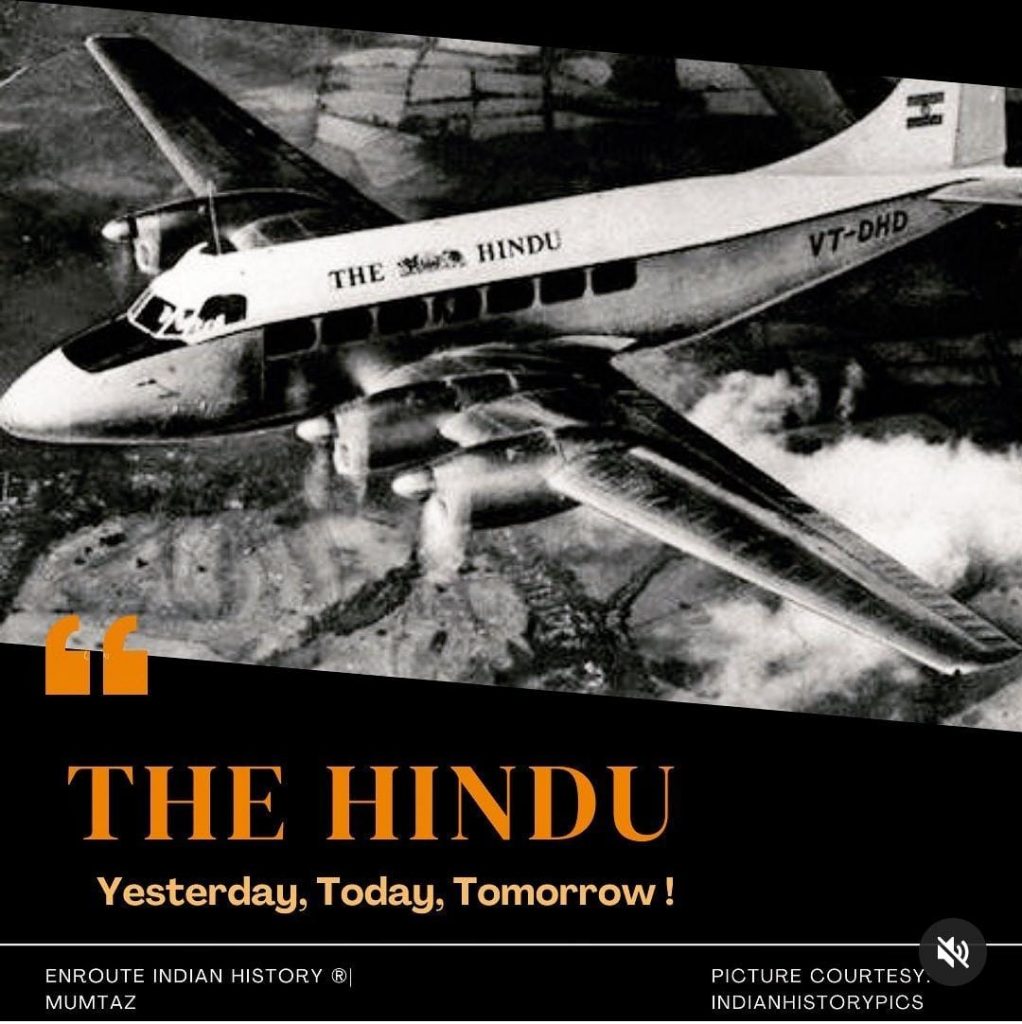
Article by EIH Researcher and Writer
Mumtaz
The history of The Hindu, a daily newspaper in English, is an inspiring story that began with the borrowed money of a rupee and three quarters to print 80 copies. Today it has a daily circulation of over 1,415,792 copies (December 2019) with a reach that has been steadily growing over the years. It is indeed an amazing story of quest and commitment towards fairness, objective journalism, and larger public welfare which has made it India’s leading dailies. For many, it’s not a paper, but emotion and a bond that has been built over centuries.“The Hindu has evolved into an institution and indeed a way of life with tens of thousands of its trusted readers”. This paper is read in Indian cities and villages alike, thanks to its commitment to honest, standard, and fearless journalism. Even in the age of misinformation and disinformation, the Hindu has maintained its sanctity by remaining adhered to principled journalism. But how did this daily emerge as India’s prestigious newspaper, a brand in itself?
The Hindu, regarded as one of India’s most influential dailies, started its journey on Sep 20, 1878, while India was still under colonial occupation. It is one of the oldest surviving major newspapers of Indian nationalism, which emerged as India’s voice in the freedom movement and played a cardinal role in the history of its freedom struggle. Though it was started as a weekly, by a group of six young nationalists including four law students and two teachers — T. Rangacharya, P. V. Rangacharya, D. Kesava Rao Pantulu, and N. Subba Rao Pantulu who were led by radical social reformers like G. Subramania Iyer and M. Veeraraghavacharyar — it soon became a daily in 1889. The Hindu and its commitment to truthfulness, and independent editorial stand earned it the accolade from The Times, London which selected it as one of the world’s ten best newspapers in 1965. The Times wrote: “It might fairly be described as a national voice with a southern accent. The Hindu can claim to be the most respected paper in India.”
During the freedom movement, it emerged as one of the dozen papers to oppose the policies of the British Raj within the Indian subcontinent. Its coverage of the freedom struggle, the lead role played by Mahatma Gandhi in it, and the Japanese surrender in the Second World War when most of the country’s morning dailies missed it-earned it special recognition. Its inaugural issue of the journal published in 100 copies at Srinidhi press in Chennai, carried a straight editorial titled ‘Ourselves’, which spoke at length on the necessity of unity for breaking the shackles of bondage and subordination (of whom). In the article, `The Hindu Experience’, S. Muthiah, a modern historian, gives us an account of the paper’s trajectory, its support for the freedom struggle, its lead on l’affaire Bofors, its stand on the Sri Lankan Tamil problem, and a campaign for widow remarriage besides other issues.
Whereas a majority of its contemporaneous counterparts have become extinct today, it has carefully maintained its position in a long journey through its flexible and adaptable approach, responding to the changing condition and environment. In the course of these years, the newspaper changed many hands who provided it with the needed replenishment and reinforcement at various times and stages. In 1905, it was purchased by lawyer S. Kasturi Ranga Iyenger, who provided the much-needed organization and financial independence. He could be termed as The Hindu‘s “first modernizer”.
The Hindu has always been a pioneer in technology. Kasturi was the most technology-oriented editor among all its editors. He was the one whose technological innovations helped the paper grow enormously. The Hindu’s first step towards reaching out to a larger readership was taken by Srinivasan who used air services to transport The Hindu. In 1962, The Hindu became the first newspaper in India to charter a plane to deliver its newspapers to its far-flung readers. It also became the world’s first newspaper to operate its own fleet of aircraft. It was a very bold and unique step in the history of journalism in India, a revolutionary move that no other paper in India had ever attempted.
However, due to its high cost, and erratic weather conditions, The Hindu replaced its aircraft operation with new methods of inter-city transmission in the late 1960s. The lead role was again taken by Kasturi. The facsimile mode of transmission was started in July 1969. In order to compete with the demand of the age, in 1983, The Hindu further equipped itself with a new Japanese printing machine to enable high-quality color printing which was replaced in 1997 with even a more sophisticated Japanese machine.
In this modernized age, when everything has become digital, a whole new generation is growing up on the Internet, it is a big challenge for newspaper journalism to maintain its hold and sway over the masses and withhold its popularity as an effective medium of communication. For this, The Hindu has molded itself in the technologically advanced age not only innovatively but beautifully too while maintaining its position amidst the intensifying competition, corruption, and economic and political pressures. In this age of prejudice and propaganda when myth has become reality and reality has turned into myth, maintaining professional journalism is a daunting task. One may ask a pertinent question. Isn’t high-quality journalism rooted in well-defined principles, one that is ethically sound and responsible to its readers alone, the only way out of this mess? This kind of journalism has a crucial role to play in such a scenario affecting the ocean of people, by not only forming a public opinion but shaping it for the best interest of the nation. The role can only be fulfilled by a serious and professional newspaper that shares a heritage with this nation and has a history of its own. Journalism that yields credible information through inquiry and investigation, without any prejudice and agenda in mind, discovering the news rather than inventing or manufacturing it. Only then can we hope for democratic and progressive outcomes. In the past, The Hindu has diligently offered its national service and fulfilled its duty, be it its constructive stand on its detailed coverage of the Arbuthnot Bank crash scandal in the first decade of the 20th century or an investigative role in the Bofors corruption scandal. It has proved its worth. With challenging times ahead, its dedication and loyalty towards the nation are again put to test. Will it stand by its core values that have been cardinal to its prestige and success? Will it continue its commitment to social good, secularism, equality against chaos, anarchy, communitarian strife, fundamentalism, and extremism? Will it act as a means of creating peace to unite people or will it spread the politics of hate, bigotry, and communalism, that is going to devastate the fabric of our country for whose freedom it has played an indelible role? Is it too much to expect from our national daily that we have adorned over the centuries and that shares a heritage of more than 140 years? Will it move with time without compromising on its core values and traditions of truth, fairness, and dependability?
References
- https://web.archive.org/web/20110430123920/http://www.hinduonnet.com/thehindu/thscrip/print.pl?file=20031010005512800.htm&date=fl2020%2F&prd=fline&
- https://web.archive.org/web/20071127134111/http://www.hinduonnet.com/thehindu/thscrip/print.pl?file=2003091301020800.htm&date=2003%2F09%2F13%2F&prd=th125&
- https://en.wikipedia.org/wiki/G._Subramania_Iyer
- https://www.tnpscthervupettagam.com/articles-detail/the-hindu-newspaper-140-year-journey/

















